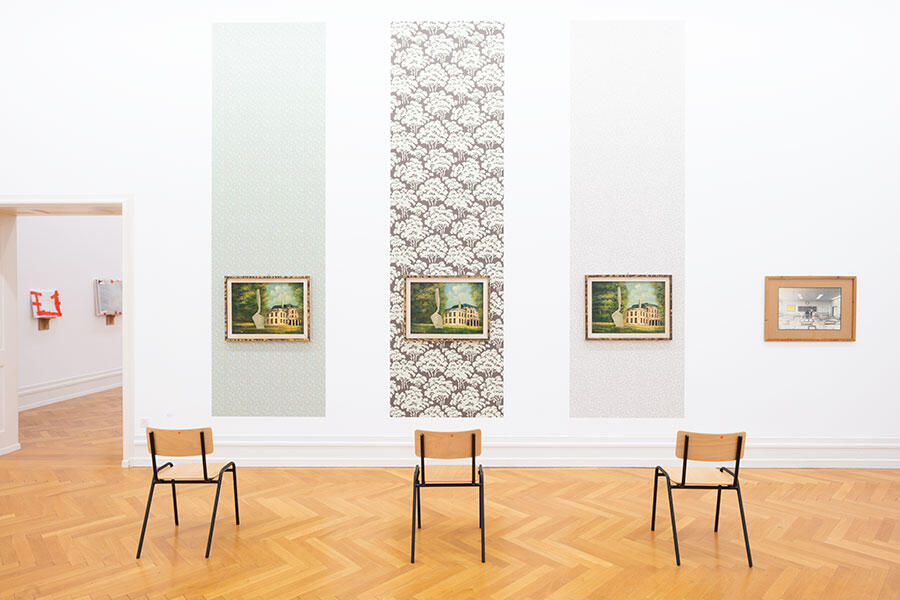Jef Geys’s Playful Iconoclasm
A survey of the artist's work at Kunsthalle Bern celebrates Geys's desire to challenge the status quo and bring art to masses
A survey of the artist's work at Kunsthalle Bern celebrates Geys's desire to challenge the status quo and bring art to masses

In the mid-1960s, the late Belgian artist Jef Geys accompanied his stepfather during his work as a cattle trader, where he made a discovery that fascinated him: cows were issued with ‘passports’. Using a card index system, the traders recorded each animal’s name, birthdate, ear-tag number, vaccination record and, within pre-printed outlines, even the markings on its hide. Geys appropriated this bureaucratic format for his series ‘Passeport de vache’ (Cow Passport, 1965–2014), in which he paired a photograph of a cow with a form that listed its birthdate, name and sex. Beneath this was a standardized black outline of the animal, which Geys filled with all manner of abstract patterns in a range of media, from coloured-pencil hatching to photo-collage.

Twenty of these ‘passports’ are included in the artist’s solo show at Kunsthalle Bern, the first exhibition dedicated to his work in Switzerland. Geys always photographed the cows standing, looking out of the frame to the left or the right. This uniformity recalls the serial approach employed by Bernd and Hilla Becher in the images they took of half-timber houses and grain silos (1950s–90s). But Geys breaks the conceptual rigour of his photographs with the work’s lower half which – of equal size and significance – contains a non-uniform, hand-illustrated element. With his subtly anarchic humour, the artist gives these otherwise anonymous animals an identity that lies somewhere between reality and fiction. Such conceptual play with seriality and variation runs throughout the exhibition in series such as ‘Middleheim Works’ (1999), in which Geys pairs framed dried plants with framed erotic drawings that, in turn, combine sex scenes with company logos.
Although Geys took part in many important international exhibitions – including the São Paulo Biennale (1991), Skulptur Projekte Münster (1997) and the Venice Biennale (2009) – his relationship to the art world seems to have been marked by a blend of scepticism and pragmatism. For a few years during the 1970s, for example, he refused to participate in exhibitions on the grounds of their being addressed exclusively to art audiences and, alongside his work as an artist, he also taught at a primary school (1960–89). This period is recalled in the exhibition by Gevoelsspeeldoos 113 (1967), a wooden case containing 80 objects for play made from wood, stone, glass and other materials – a stripped-back approach reminiscent of the educational theories of the Bauhaus. Similarly, his life-size puppets-cum-sculptures – Brigitte Bardot (1966), Yellow Puppet (1967) and The Ghost (1967) – reflect his interest in the avant-garde practices of Oskar Schlemmer and Sophie Taeuber-Arp.

Geys’s desire to bring art to the masses extended beyond the school system. In 1969, he co-founded Bar 900 – a pub for which he also organized cultural programmes – and, when his local newspaper ran into financial difficulties in the early 1970s, he took over as publisher, transforming Kempens Informatieblad into an artistic project that offered a combination of local and cultural news. With the publication Kempens Informatieboek – Special Edition – Kunsthalle Bern (2021), the museum pays fitting tribute to Geys by appropriating his original journal’s austere, copy-shop design to provide information about the exhibition in a takeaway format. Ultimately, Geys’s attempts to bring art into everyday life keep his work highly relevant today: what an artist is, and how they should position themselves within society, are questions we must never stop asking.
Main image: Jef Geys at Kunsthalle Bern, 2021, installation view, Kunsthalle Bern. Courtesy: KAZINI and Jef Geys Estate; photograph:Stefan Burger
























